HI6028 Taxation Law: Assignment Questions, Holmes Institute T1 2019
VerifiedAdded on 2023/03/23
|9
|2327
|72
Homework Assignment
AI Summary
This assignment solution addresses several taxation law questions. It covers the application of Capital Gains Tax (CGT) to transactions involving the sale of collectibles, analyzing whether exemptions apply based on acquisition dates and personal use. It also examines whether income derived from writing and selling a book constitutes income from personal exertion, and the tax implications of loan repayments. The analysis references relevant sections of the ITAA 36 and ITAA 97, as well as case law, to provide comprehensive answers. Desklib offers a range of study tools and solved assignments for students.
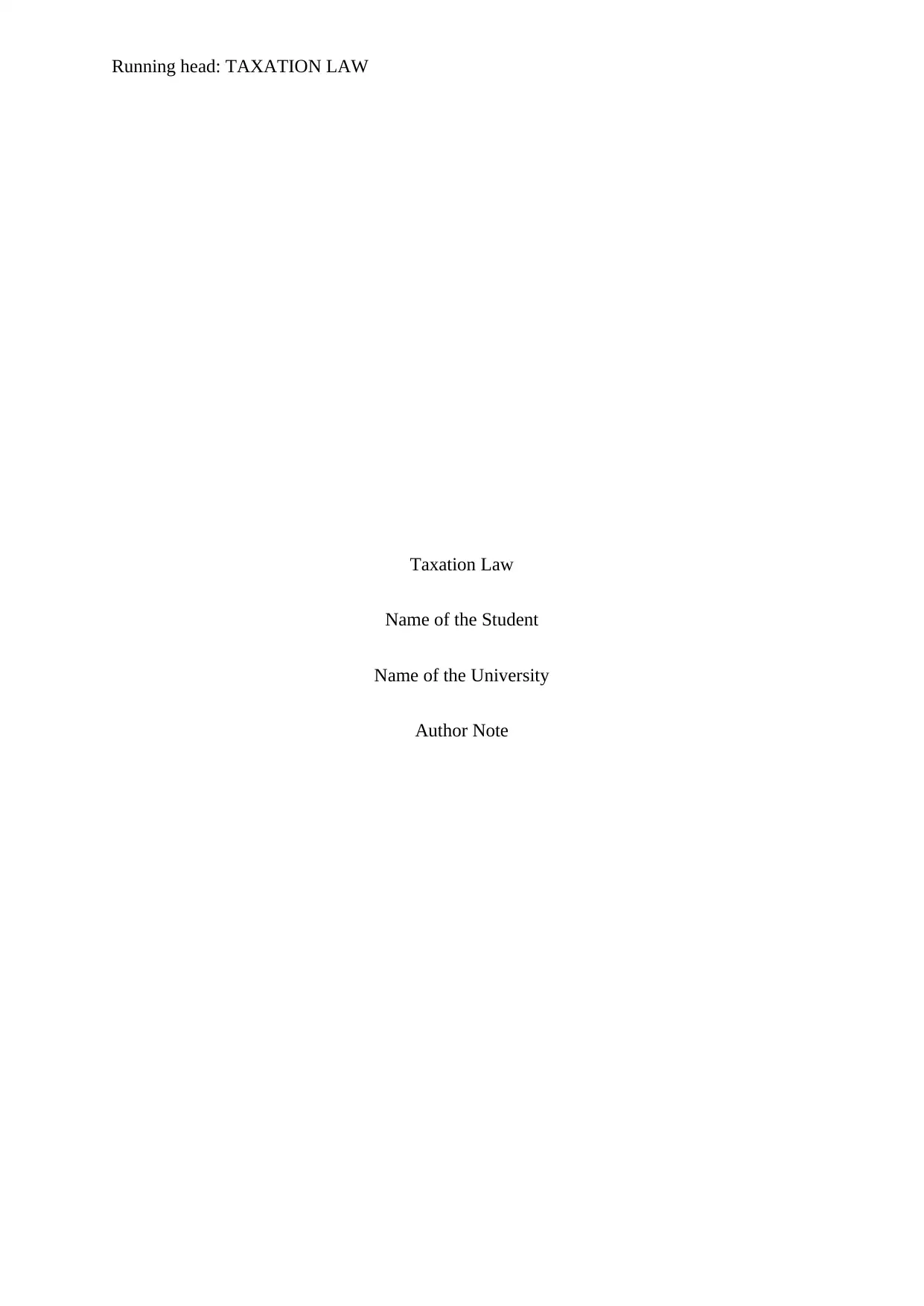
Running head: TAXATION LAW
Taxation Law
Name of the Student
Name of the University
Author Note
Taxation Law
Name of the Student
Name of the University
Author Note
Paraphrase This Document
Need a fresh take? Get an instant paraphrase of this document with our AI Paraphraser

1TAXATION LAW
Question 1
Issue
The issue raised in this present scenario is whether the transactions entered into by Helen
with the objective of funding for fashion designing business will be subjected to Capital Gain
Tax. The first transaction involves the selling of a painting on the 1st of December 2018 for a
price of $12,000 which has been acquired by Helen’s father in the year February of 1985 for
price of $4000. The second transaction involves the selling of historical sculpture on the 1st
of January 2018 for a price of $6000 which she acquired for $5,500 on December 1993. The
third transaction involves the selling of an antique jewellery for a price of $13,000 on 20th of
March 2018 which has been acquired on October 1987 for price of $14,000. The fourth
transaction involves the selling of a picture for a price of $5,000 which has been purchased
by her mother on march 1987 for price of $470.
Rule
The profits or losses that accrues for the manifestation of CGT event will be e rendered as
profit or loss, which need to be subjected to CGT as u/s 102. 20 of the ITAA 97. Any transfer
of CGT asset by way of sale will be treated as an event, which falls under the category of
CGT event A1. This CGT consequences will only be applied to a CGT asset if the same has
been availed after 20th of September of the year 1985. The assets, which has been availed
before this prescribed date will not be considered to be taxed under CGT and will be treated
as an exemption from the same.
The ITAA 97 provides for the definition of the word collectible u/s 108.10(2). Any item
that a taxpayer owns for the purpose of use and enjoyment in a personal capacity without
having any direct relation with his income earning process will be e treated as a collectible as
defined under this section. Collectible can be an antique object, rare folio or even a jewellery.
Question 1
Issue
The issue raised in this present scenario is whether the transactions entered into by Helen
with the objective of funding for fashion designing business will be subjected to Capital Gain
Tax. The first transaction involves the selling of a painting on the 1st of December 2018 for a
price of $12,000 which has been acquired by Helen’s father in the year February of 1985 for
price of $4000. The second transaction involves the selling of historical sculpture on the 1st
of January 2018 for a price of $6000 which she acquired for $5,500 on December 1993. The
third transaction involves the selling of an antique jewellery for a price of $13,000 on 20th of
March 2018 which has been acquired on October 1987 for price of $14,000. The fourth
transaction involves the selling of a picture for a price of $5,000 which has been purchased
by her mother on march 1987 for price of $470.
Rule
The profits or losses that accrues for the manifestation of CGT event will be e rendered as
profit or loss, which need to be subjected to CGT as u/s 102. 20 of the ITAA 97. Any transfer
of CGT asset by way of sale will be treated as an event, which falls under the category of
CGT event A1. This CGT consequences will only be applied to a CGT asset if the same has
been availed after 20th of September of the year 1985. The assets, which has been availed
before this prescribed date will not be considered to be taxed under CGT and will be treated
as an exemption from the same.
The ITAA 97 provides for the definition of the word collectible u/s 108.10(2). Any item
that a taxpayer owns for the purpose of use and enjoyment in a personal capacity without
having any direct relation with his income earning process will be e treated as a collectible as
defined under this section. Collectible can be an antique object, rare folio or even a jewellery.
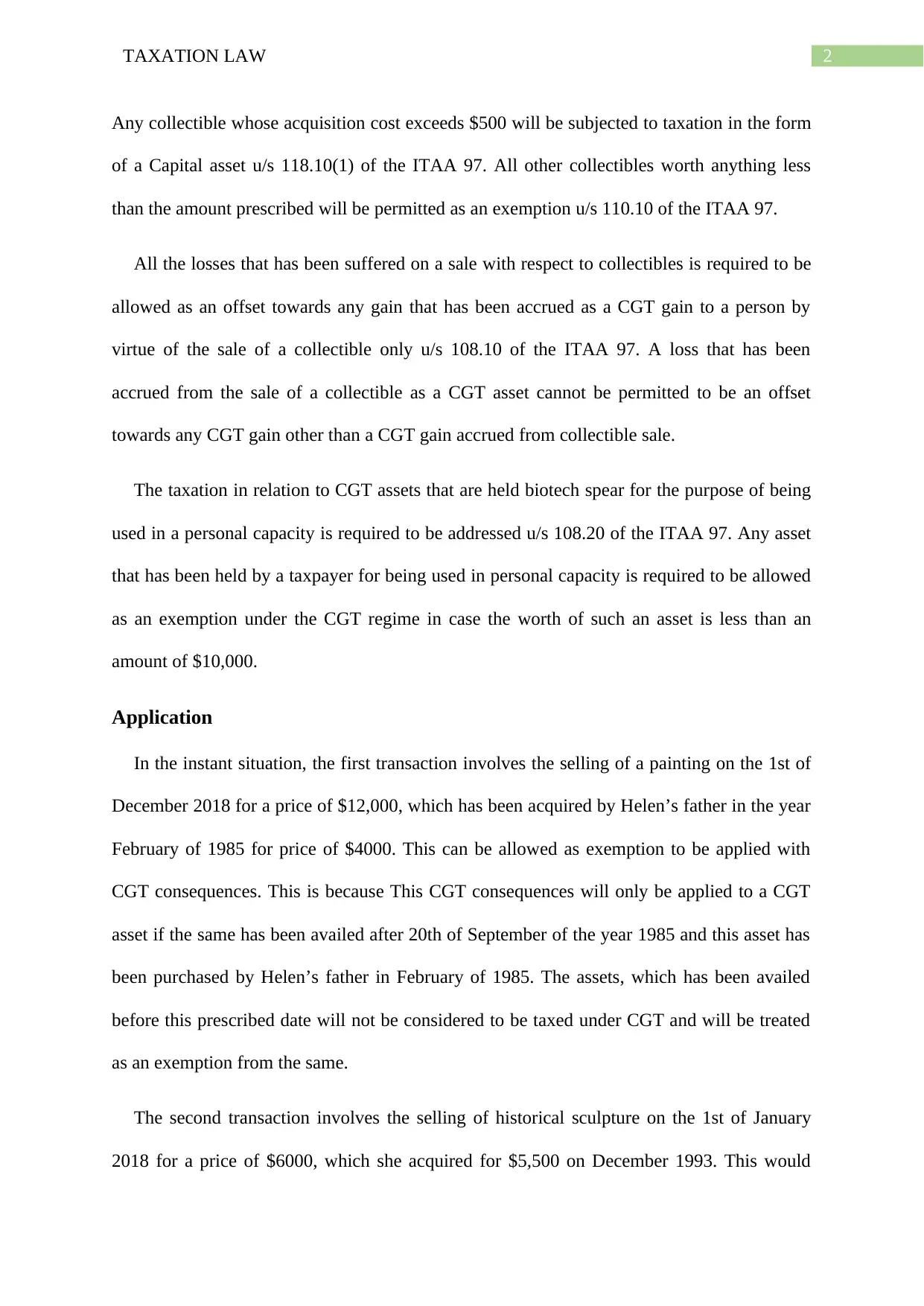
2TAXATION LAW
Any collectible whose acquisition cost exceeds $500 will be subjected to taxation in the form
of a Capital asset u/s 118.10(1) of the ITAA 97. All other collectibles worth anything less
than the amount prescribed will be permitted as an exemption u/s 110.10 of the ITAA 97.
All the losses that has been suffered on a sale with respect to collectibles is required to be
allowed as an offset towards any gain that has been accrued as a CGT gain to a person by
virtue of the sale of a collectible only u/s 108.10 of the ITAA 97. A loss that has been
accrued from the sale of a collectible as a CGT asset cannot be permitted to be an offset
towards any CGT gain other than a CGT gain accrued from collectible sale.
The taxation in relation to CGT assets that are held biotech spear for the purpose of being
used in a personal capacity is required to be addressed u/s 108.20 of the ITAA 97. Any asset
that has been held by a taxpayer for being used in personal capacity is required to be allowed
as an exemption under the CGT regime in case the worth of such an asset is less than an
amount of $10,000.
Application
In the instant situation, the first transaction involves the selling of a painting on the 1st of
December 2018 for a price of $12,000, which has been acquired by Helen’s father in the year
February of 1985 for price of $4000. This can be allowed as exemption to be applied with
CGT consequences. This is because This CGT consequences will only be applied to a CGT
asset if the same has been availed after 20th of September of the year 1985 and this asset has
been purchased by Helen’s father in February of 1985. The assets, which has been availed
before this prescribed date will not be considered to be taxed under CGT and will be treated
as an exemption from the same.
The second transaction involves the selling of historical sculpture on the 1st of January
2018 for a price of $6000, which she acquired for $5,500 on December 1993. This would
Any collectible whose acquisition cost exceeds $500 will be subjected to taxation in the form
of a Capital asset u/s 118.10(1) of the ITAA 97. All other collectibles worth anything less
than the amount prescribed will be permitted as an exemption u/s 110.10 of the ITAA 97.
All the losses that has been suffered on a sale with respect to collectibles is required to be
allowed as an offset towards any gain that has been accrued as a CGT gain to a person by
virtue of the sale of a collectible only u/s 108.10 of the ITAA 97. A loss that has been
accrued from the sale of a collectible as a CGT asset cannot be permitted to be an offset
towards any CGT gain other than a CGT gain accrued from collectible sale.
The taxation in relation to CGT assets that are held biotech spear for the purpose of being
used in a personal capacity is required to be addressed u/s 108.20 of the ITAA 97. Any asset
that has been held by a taxpayer for being used in personal capacity is required to be allowed
as an exemption under the CGT regime in case the worth of such an asset is less than an
amount of $10,000.
Application
In the instant situation, the first transaction involves the selling of a painting on the 1st of
December 2018 for a price of $12,000, which has been acquired by Helen’s father in the year
February of 1985 for price of $4000. This can be allowed as exemption to be applied with
CGT consequences. This is because This CGT consequences will only be applied to a CGT
asset if the same has been availed after 20th of September of the year 1985 and this asset has
been purchased by Helen’s father in February of 1985. The assets, which has been availed
before this prescribed date will not be considered to be taxed under CGT and will be treated
as an exemption from the same.
The second transaction involves the selling of historical sculpture on the 1st of January
2018 for a price of $6000, which she acquired for $5,500 on December 1993. This would
⊘ This is a preview!⊘
Do you want full access?
Subscribe today to unlock all pages.

Trusted by 1+ million students worldwide

3TAXATION LAW
have the tax consequence as a CGT asset. This is because any collectible whose acquisition
cost exceeds $500 will be subjected to taxation in the form of a Capital asset u/s 118.10(1) of
the ITAA 97. All other collectibles worth anything less than the amount prescribed will be
permitted as an exemption u/s 110.10 of the ITAA 97.
The third transaction involves the selling of an antique jewellery for a price of $13,000 on
20th of March 2018, which has been acquired on October 1987 for price of $14,000. This
needs to be allowed as offset against any other CGT gain that has been accrued for a sale of a
collectible. This is because all the losses that has been suffered on a sale with respect to
collectibles is required to be allowed as an offset towards any gain that has been accrued as a
CGT gain to a person by virtue of the sale of a collectible only u/s 108.10 of the ITAA 97.
The fourth transaction involves the selling of a picture for a price of $5,000 which has
been purchased by her mother on march 1987 for price of $470. This needs to be treated as a
exempt from CGT asset as the same has been held by the taxpayer for the purpose of being
used under personal capacity. This is because u/s 108.20 of the ITAA 97 any asset that has
been held by a taxpayer for being used in personal capacity is required to be allowed as an
exemption under the CGT regime in case the worth of such an asset is less than an amount of
$10,000.
Conclusion
The selling of a painting on the 1st of December 2018 for a price of $12,000, which has
been acquired by Helen’s father in the year February of 1985 for price of $4000 can be
allowed as exemption to be applied with CGT consequences. The selling of historical
sculpture on the 1st of January 2018 for a price of $6000, which she acquired for $5,500 on
December 1993 would have the tax consequence as a CGT asset. The selling of an antique
jewellery for a price of $13,000 on 20th of March 2018, which has been acquired on October
have the tax consequence as a CGT asset. This is because any collectible whose acquisition
cost exceeds $500 will be subjected to taxation in the form of a Capital asset u/s 118.10(1) of
the ITAA 97. All other collectibles worth anything less than the amount prescribed will be
permitted as an exemption u/s 110.10 of the ITAA 97.
The third transaction involves the selling of an antique jewellery for a price of $13,000 on
20th of March 2018, which has been acquired on October 1987 for price of $14,000. This
needs to be allowed as offset against any other CGT gain that has been accrued for a sale of a
collectible. This is because all the losses that has been suffered on a sale with respect to
collectibles is required to be allowed as an offset towards any gain that has been accrued as a
CGT gain to a person by virtue of the sale of a collectible only u/s 108.10 of the ITAA 97.
The fourth transaction involves the selling of a picture for a price of $5,000 which has
been purchased by her mother on march 1987 for price of $470. This needs to be treated as a
exempt from CGT asset as the same has been held by the taxpayer for the purpose of being
used under personal capacity. This is because u/s 108.20 of the ITAA 97 any asset that has
been held by a taxpayer for being used in personal capacity is required to be allowed as an
exemption under the CGT regime in case the worth of such an asset is less than an amount of
$10,000.
Conclusion
The selling of a painting on the 1st of December 2018 for a price of $12,000, which has
been acquired by Helen’s father in the year February of 1985 for price of $4000 can be
allowed as exemption to be applied with CGT consequences. The selling of historical
sculpture on the 1st of January 2018 for a price of $6000, which she acquired for $5,500 on
December 1993 would have the tax consequence as a CGT asset. The selling of an antique
jewellery for a price of $13,000 on 20th of March 2018, which has been acquired on October
Paraphrase This Document
Need a fresh take? Get an instant paraphrase of this document with our AI Paraphraser

4TAXATION LAW
1987 for price of $14,000 needs to be allowed as offset against any other CGT gain that has
been accrued for a sale of a collectible. The selling of a picture for a price of $5,000 which
has been purchased by her mother on March 1987 for price of $470 needs to be treated as a
exempt from CGT asset as the same has been held by the taxpayer for the purpose of being
used under personal capacity.
Question 2
Issue
The issues data arising from the instant scenario is whether the transactions entered into by
Barbara will yield income which has been on from personal exertion for the purpose of
taxation. Whether the consequence of taxation would have been different if the book has been
written prior to the signing of the contract and was decided to be sold later on.
Rule
The expression income from personal exertion has been defined u/s 6 of the ITAA 36.
When income is earned by virtue of the efforts that has been extended by a taxpayer in the
furtherance of his income generation process will be treated as income derived from personal
exertion. This form of income will include earning salaries, fees, wages and other allowances
of similar nature. This form of income will also include all the receipts that a taxpayer
receives by virtue of his services being rendered as an employee. The income that accrues
from business activity in which the taxpayer is acting as a partner or is carrying out the
transactions of the business alone will also be brought under the range of income from
personal exertion. In case a person desirous to bring an income under the purview of this
section he needs to establish approximate connection existing among his income and his
personal efforts for the purpose of earning that income.
1987 for price of $14,000 needs to be allowed as offset against any other CGT gain that has
been accrued for a sale of a collectible. The selling of a picture for a price of $5,000 which
has been purchased by her mother on March 1987 for price of $470 needs to be treated as a
exempt from CGT asset as the same has been held by the taxpayer for the purpose of being
used under personal capacity.
Question 2
Issue
The issues data arising from the instant scenario is whether the transactions entered into by
Barbara will yield income which has been on from personal exertion for the purpose of
taxation. Whether the consequence of taxation would have been different if the book has been
written prior to the signing of the contract and was decided to be sold later on.
Rule
The expression income from personal exertion has been defined u/s 6 of the ITAA 36.
When income is earned by virtue of the efforts that has been extended by a taxpayer in the
furtherance of his income generation process will be treated as income derived from personal
exertion. This form of income will include earning salaries, fees, wages and other allowances
of similar nature. This form of income will also include all the receipts that a taxpayer
receives by virtue of his services being rendered as an employee. The income that accrues
from business activity in which the taxpayer is acting as a partner or is carrying out the
transactions of the business alone will also be brought under the range of income from
personal exertion. In case a person desirous to bring an income under the purview of this
section he needs to establish approximate connection existing among his income and his
personal efforts for the purpose of earning that income.
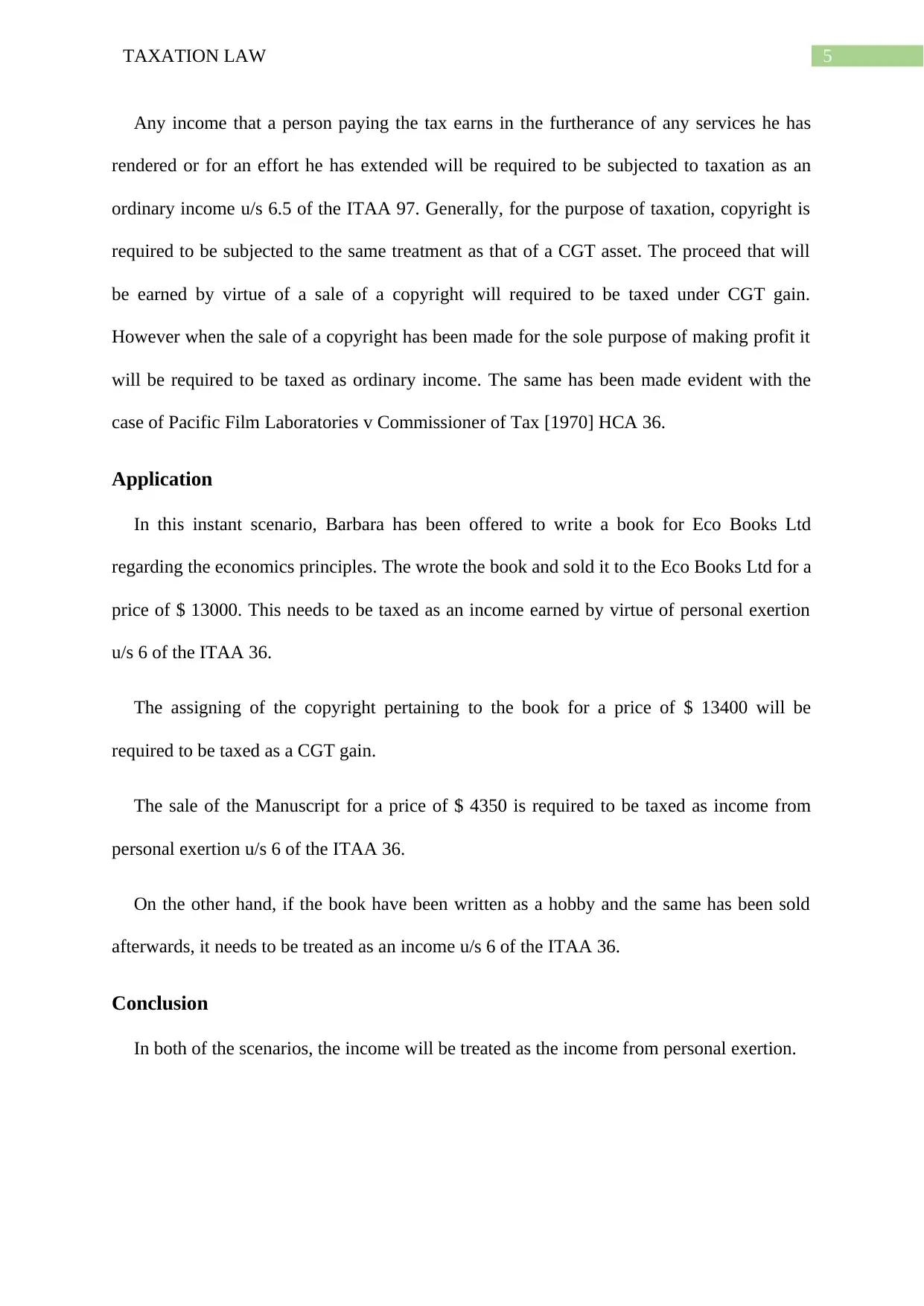
5TAXATION LAW
Any income that a person paying the tax earns in the furtherance of any services he has
rendered or for an effort he has extended will be required to be subjected to taxation as an
ordinary income u/s 6.5 of the ITAA 97. Generally, for the purpose of taxation, copyright is
required to be subjected to the same treatment as that of a CGT asset. The proceed that will
be earned by virtue of a sale of a copyright will required to be taxed under CGT gain.
However when the sale of a copyright has been made for the sole purpose of making profit it
will be required to be taxed as ordinary income. The same has been made evident with the
case of Pacific Film Laboratories v Commissioner of Tax [1970] HCA 36.
Application
In this instant scenario, Barbara has been offered to write a book for Eco Books Ltd
regarding the economics principles. The wrote the book and sold it to the Eco Books Ltd for a
price of $ 13000. This needs to be taxed as an income earned by virtue of personal exertion
u/s 6 of the ITAA 36.
The assigning of the copyright pertaining to the book for a price of $ 13400 will be
required to be taxed as a CGT gain.
The sale of the Manuscript for a price of $ 4350 is required to be taxed as income from
personal exertion u/s 6 of the ITAA 36.
On the other hand, if the book have been written as a hobby and the same has been sold
afterwards, it needs to be treated as an income u/s 6 of the ITAA 36.
Conclusion
In both of the scenarios, the income will be treated as the income from personal exertion.
Any income that a person paying the tax earns in the furtherance of any services he has
rendered or for an effort he has extended will be required to be subjected to taxation as an
ordinary income u/s 6.5 of the ITAA 97. Generally, for the purpose of taxation, copyright is
required to be subjected to the same treatment as that of a CGT asset. The proceed that will
be earned by virtue of a sale of a copyright will required to be taxed under CGT gain.
However when the sale of a copyright has been made for the sole purpose of making profit it
will be required to be taxed as ordinary income. The same has been made evident with the
case of Pacific Film Laboratories v Commissioner of Tax [1970] HCA 36.
Application
In this instant scenario, Barbara has been offered to write a book for Eco Books Ltd
regarding the economics principles. The wrote the book and sold it to the Eco Books Ltd for a
price of $ 13000. This needs to be taxed as an income earned by virtue of personal exertion
u/s 6 of the ITAA 36.
The assigning of the copyright pertaining to the book for a price of $ 13400 will be
required to be taxed as a CGT gain.
The sale of the Manuscript for a price of $ 4350 is required to be taxed as income from
personal exertion u/s 6 of the ITAA 36.
On the other hand, if the book have been written as a hobby and the same has been sold
afterwards, it needs to be treated as an income u/s 6 of the ITAA 36.
Conclusion
In both of the scenarios, the income will be treated as the income from personal exertion.
⊘ This is a preview!⊘
Do you want full access?
Subscribe today to unlock all pages.

Trusted by 1+ million students worldwide
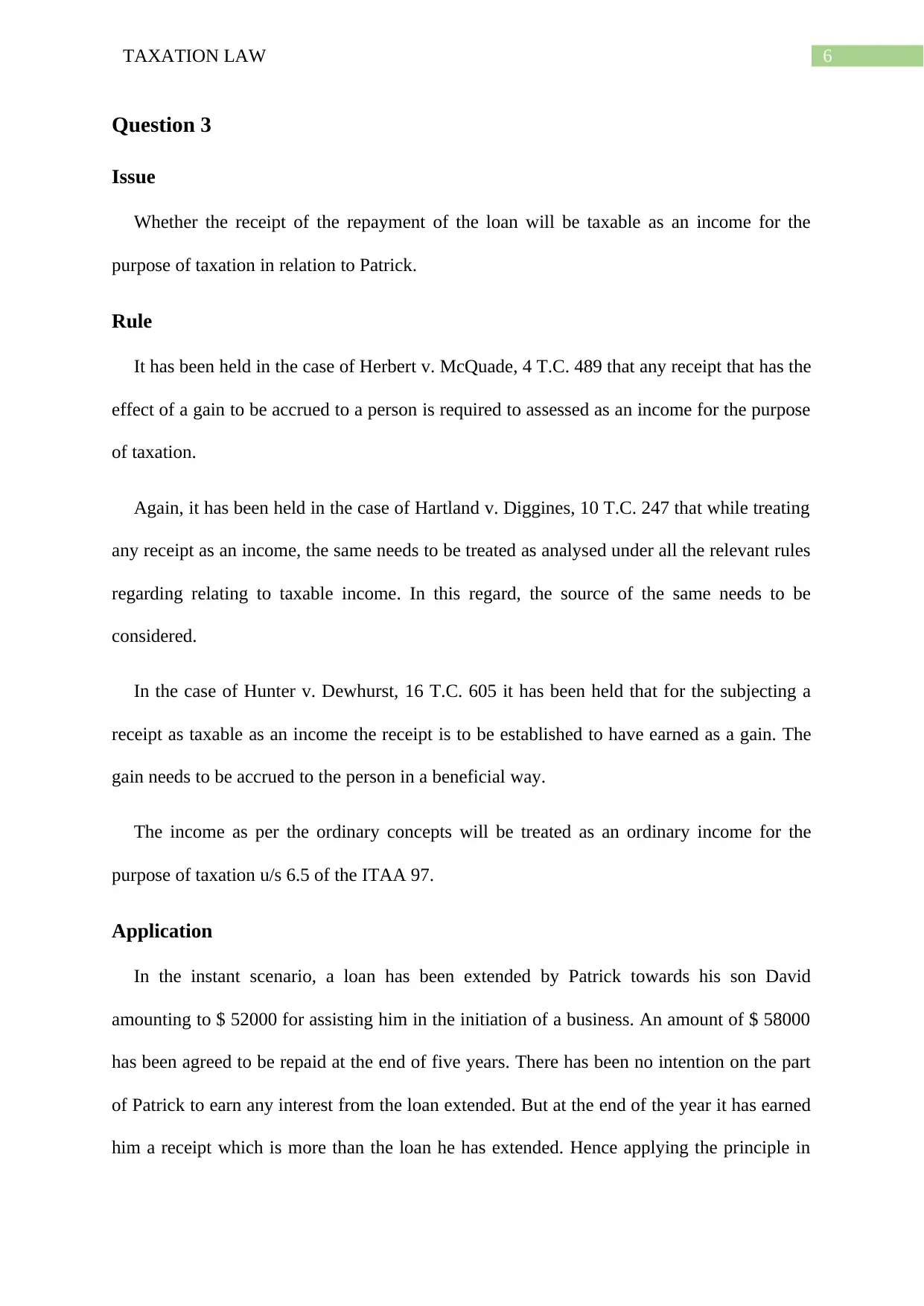
6TAXATION LAW
Question 3
Issue
Whether the receipt of the repayment of the loan will be taxable as an income for the
purpose of taxation in relation to Patrick.
Rule
It has been held in the case of Herbert v. McQuade, 4 T.C. 489 that any receipt that has the
effect of a gain to be accrued to a person is required to assessed as an income for the purpose
of taxation.
Again, it has been held in the case of Hartland v. Diggines, 10 T.C. 247 that while treating
any receipt as an income, the same needs to be treated as analysed under all the relevant rules
regarding relating to taxable income. In this regard, the source of the same needs to be
considered.
In the case of Hunter v. Dewhurst, 16 T.C. 605 it has been held that for the subjecting a
receipt as taxable as an income the receipt is to be established to have earned as a gain. The
gain needs to be accrued to the person in a beneficial way.
The income as per the ordinary concepts will be treated as an ordinary income for the
purpose of taxation u/s 6.5 of the ITAA 97.
Application
In the instant scenario, a loan has been extended by Patrick towards his son David
amounting to $ 52000 for assisting him in the initiation of a business. An amount of $ 58000
has been agreed to be repaid at the end of five years. There has been no intention on the part
of Patrick to earn any interest from the loan extended. But at the end of the year it has earned
him a receipt which is more than the loan he has extended. Hence applying the principle in
Question 3
Issue
Whether the receipt of the repayment of the loan will be taxable as an income for the
purpose of taxation in relation to Patrick.
Rule
It has been held in the case of Herbert v. McQuade, 4 T.C. 489 that any receipt that has the
effect of a gain to be accrued to a person is required to assessed as an income for the purpose
of taxation.
Again, it has been held in the case of Hartland v. Diggines, 10 T.C. 247 that while treating
any receipt as an income, the same needs to be treated as analysed under all the relevant rules
regarding relating to taxable income. In this regard, the source of the same needs to be
considered.
In the case of Hunter v. Dewhurst, 16 T.C. 605 it has been held that for the subjecting a
receipt as taxable as an income the receipt is to be established to have earned as a gain. The
gain needs to be accrued to the person in a beneficial way.
The income as per the ordinary concepts will be treated as an ordinary income for the
purpose of taxation u/s 6.5 of the ITAA 97.
Application
In the instant scenario, a loan has been extended by Patrick towards his son David
amounting to $ 52000 for assisting him in the initiation of a business. An amount of $ 58000
has been agreed to be repaid at the end of five years. There has been no intention on the part
of Patrick to earn any interest from the loan extended. But at the end of the year it has earned
him a receipt which is more than the loan he has extended. Hence applying the principle in
Paraphrase This Document
Need a fresh take? Get an instant paraphrase of this document with our AI Paraphraser
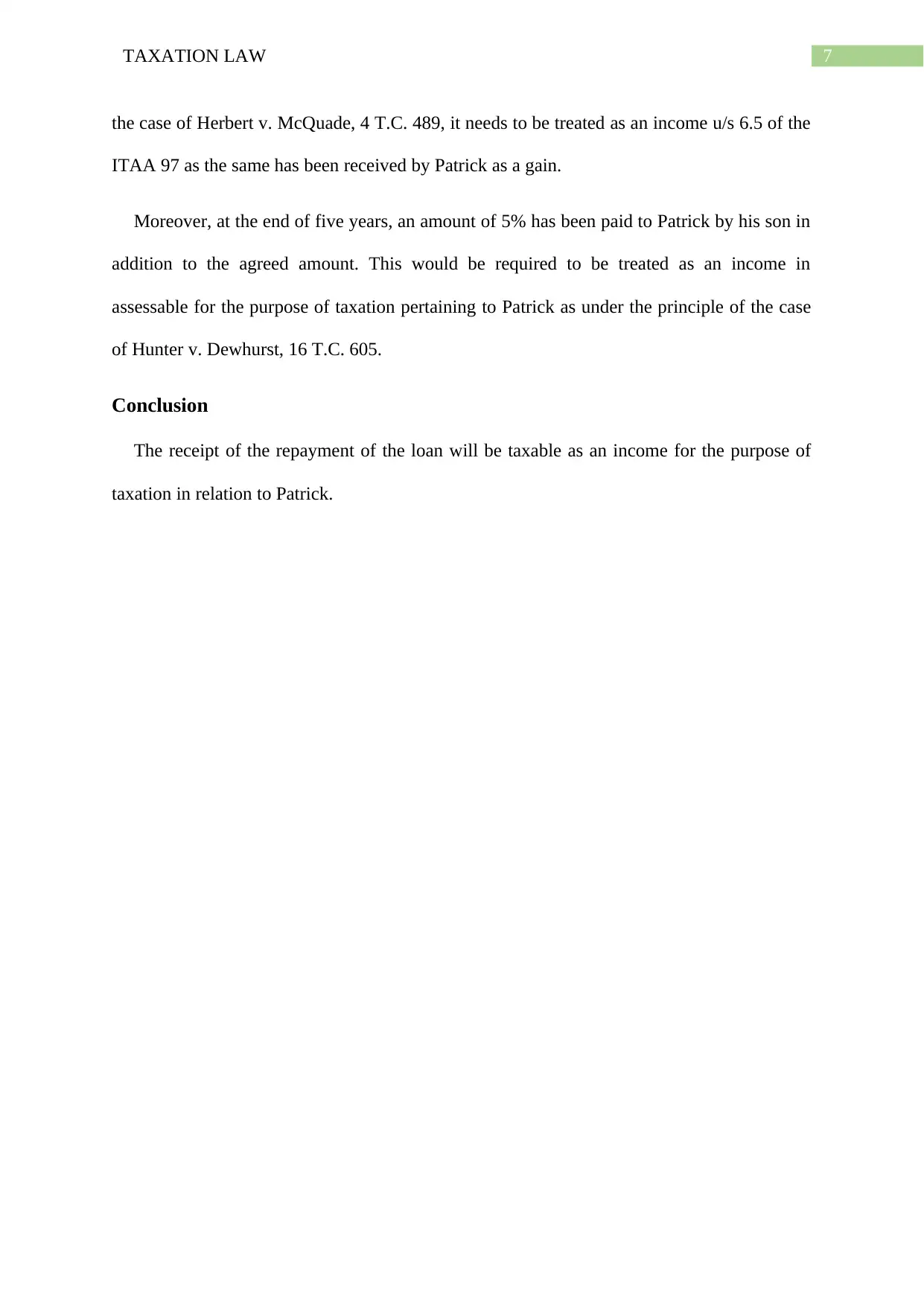
7TAXATION LAW
the case of Herbert v. McQuade, 4 T.C. 489, it needs to be treated as an income u/s 6.5 of the
ITAA 97 as the same has been received by Patrick as a gain.
Moreover, at the end of five years, an amount of 5% has been paid to Patrick by his son in
addition to the agreed amount. This would be required to be treated as an income in
assessable for the purpose of taxation pertaining to Patrick as under the principle of the case
of Hunter v. Dewhurst, 16 T.C. 605.
Conclusion
The receipt of the repayment of the loan will be taxable as an income for the purpose of
taxation in relation to Patrick.
the case of Herbert v. McQuade, 4 T.C. 489, it needs to be treated as an income u/s 6.5 of the
ITAA 97 as the same has been received by Patrick as a gain.
Moreover, at the end of five years, an amount of 5% has been paid to Patrick by his son in
addition to the agreed amount. This would be required to be treated as an income in
assessable for the purpose of taxation pertaining to Patrick as under the principle of the case
of Hunter v. Dewhurst, 16 T.C. 605.
Conclusion
The receipt of the repayment of the loan will be taxable as an income for the purpose of
taxation in relation to Patrick.
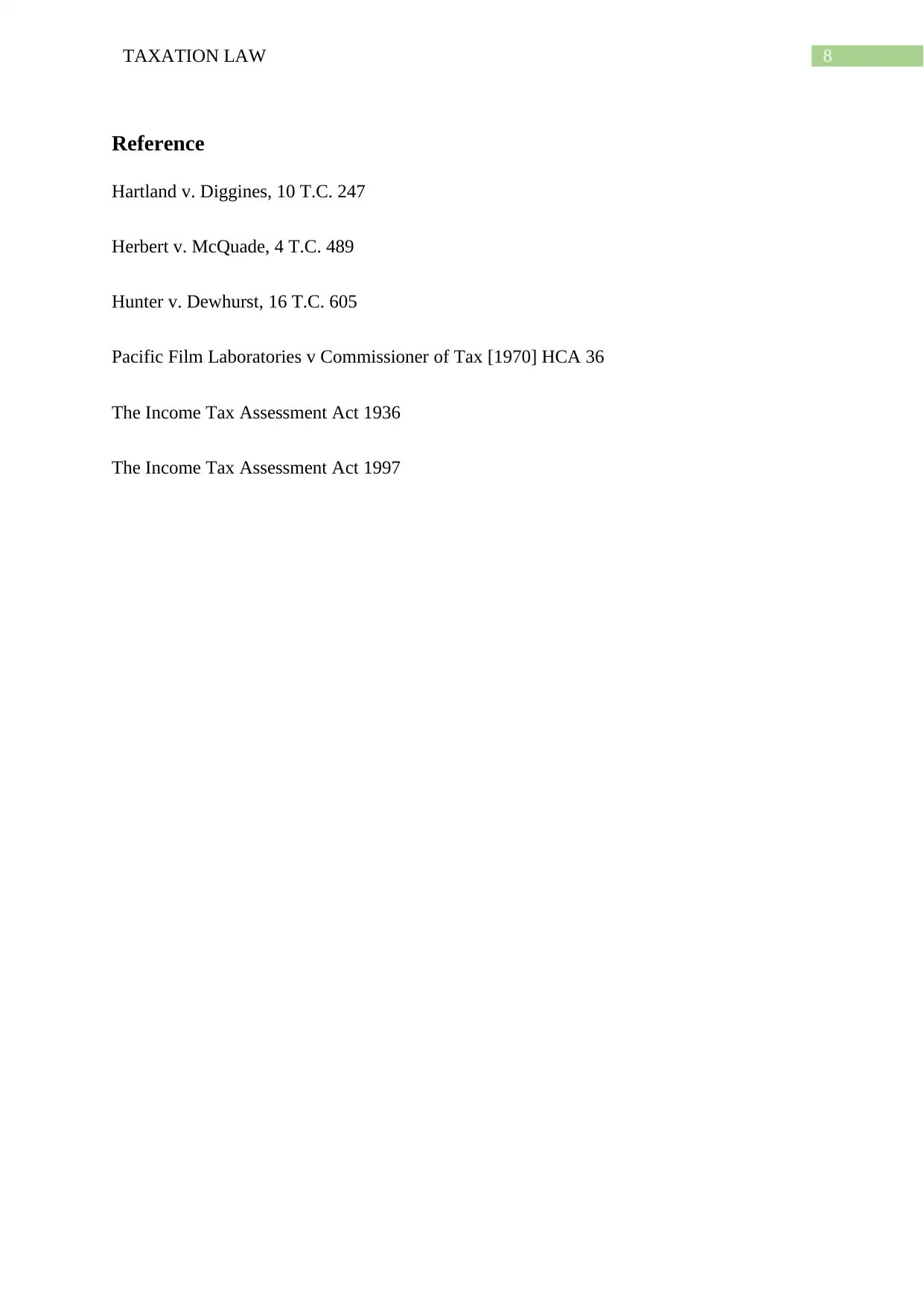
8TAXATION LAW
Reference
Hartland v. Diggines, 10 T.C. 247
Herbert v. McQuade, 4 T.C. 489
Hunter v. Dewhurst, 16 T.C. 605
Pacific Film Laboratories v Commissioner of Tax [1970] HCA 36
The Income Tax Assessment Act 1936
The Income Tax Assessment Act 1997
Reference
Hartland v. Diggines, 10 T.C. 247
Herbert v. McQuade, 4 T.C. 489
Hunter v. Dewhurst, 16 T.C. 605
Pacific Film Laboratories v Commissioner of Tax [1970] HCA 36
The Income Tax Assessment Act 1936
The Income Tax Assessment Act 1997
⊘ This is a preview!⊘
Do you want full access?
Subscribe today to unlock all pages.

Trusted by 1+ million students worldwide
1 out of 9
Related Documents
Your All-in-One AI-Powered Toolkit for Academic Success.
+13062052269
info@desklib.com
Available 24*7 on WhatsApp / Email
![[object Object]](/_next/static/media/star-bottom.7253800d.svg)
Unlock your academic potential
Copyright © 2020–2025 A2Z Services. All Rights Reserved. Developed and managed by ZUCOL.





